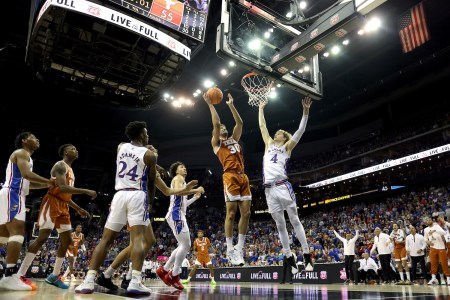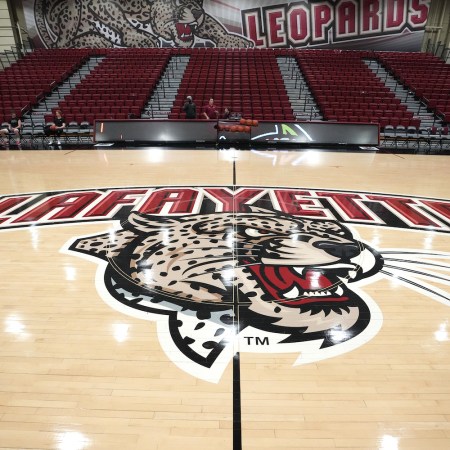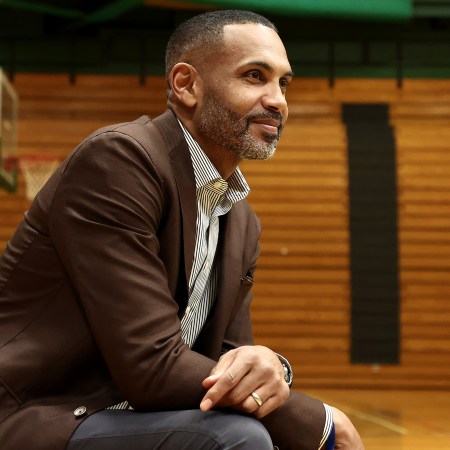The best basketball prospect in the world is the 7-foot, 5-inch superfreak Frenchman Victor Wembanyama, who possesses every conceivable athletic skill you’d want on the hardwood (size, length, touch, range and uncanny defensive reflexes) and is currently playing for some afterthought program in Paris. The second best prospect? Scoot Henderson, a ridiculously potent point guard in the Westbrook phylum that would absolutely go number one in any draft that didn’t also include a literal basketball alien. Henderson is currently playing for the G League — the NBA’s developmental division — which means he isn’t currently chipping away at a degree.
All this is to say that neither Wembanyama nor Henderson will be appearing at March Madness. They are not attending Duke, North Carolina, Kansas or any other wreathed blue blood institution. The projectional drop-off between those two players and the rest of 2023’s draft stock is more like a chasm, so when you amble around the bracket next week, don’t expect to witness the first intrepid steps of the certified Next Big Thing. This year’s tournament will not pave the pathway for Zion Williamson’s ascension, nor will a Carmelo Anthony facsimile lead Syracuse to fortune and glory. Instead, this upcoming batch of college basketball is going to be a perfect distillation of the sport’s fundamentals — overhead passes around the perimeter, clumsy post moves, bad footwork and 62 to 55 final scores. At last, March Madness is collegiate once again. There are no stars in sight. This might sound crazy, but I can’t wait.
The imprisoning policies the NBA has saddled college basketball with have always been indefensible. It was stupid in the late 60s when Kareem Abdul-Jabbar was already the best player in the world as a teenager and still was expected to spend four years at UCLA. (Imagine, if he had gone professional instead of schlepping off to college, his vaunted scoring record might still be out of LeBron’s reach.)
Today, NBA prospects generally spend one year at school because they rightfully want to sign a multimillion dollar contract as soon as possible, rather than play on middling teams in outrageously depressing American townships — think Bloomington, Auburn, the dreaded South Bend. This dynamic has created some baffling, paradoxical situations, where the powers that be can only blame themselves. Kyrie Irving — a brilliant point guard and test-case for the necrotic impact that unfiltered YouTube exposure can have on the minds of young men — technically was a Duke Blue Devil during his amateur career. He logged exactly 11 games for Coach K before entering the draft and leaving higher education in the dust. It is one of the very few genuinely smart decisions Irving has ever made.
The 5 Most-Compelling Storylines of This Year’s NCAA Men’s Basketball Tournament
March Madness is sure to bring its usual dose of insanity in 2023 — maybe even moreThe whole racket of college athletics has started to finally, mercifully break over the course of the last few seasons. NCAA programs are now allowed to hand over NIL deals to their recruits — letting them leverage their name, image and likeness into rich streams of capital — which is why Archie Manning, who has yet to play a down for the University of Texas, stands to bag $3.5 million. This sort of financial subterfuge was always happening in the industry; remember when Reggie Bush was cruelly stripped of his Heisman trophy because he dared to take a few checks as a teenager? Thank god the backroom deals must now be brokered in the harsh light of day.
Amateur basketball players also have plenty more options to get noticed by scouts without lending their labor to a scholastic institution. If they go play in the G League — like Henderson — they can make a healthy $125,000 a year. Barring that, you can always pull a LaMelo Ball, traipsing overseas for a year because the Australian hardwood league doesn’t require its participants to hold a solitary semester of college and an eternally undeclared major.
So this is probably the new normal for the NCAA tournament — an amateur basketball derby that has been totally hollowed out of its high-end talent. Good riddance! I wish them all the best at the draft, but I won’t miss them in March. We ought to live in a world where there are no professionals in a distinctly unprofessional environment, where campuses aren’t exclusively an incubator for the next batch of stars. What do the fogeys complain about most when it comes to the current state of the sport? Mostly that the players don’t stay in school long enough for the fans to build lasting relationships with them. Consider the Fab Five of Michigan State, which rostered four future NBA players and went to back-to-back NCAA championships in 1992 and 1993. That would never happen now. But guess what? Your wish is coming true. College basketball is back at its roots; a bunch of guys who will soon be accountants and dentists but are about to reach the apex of their athletic career at age 20. I promise you, they’ll be sticking around for all four years.
So give me solid fundamentals and a low athletic floor. Give me point guards that can’t dunk and centers that can’t jump. Give me the sort of YMCA low-post craftiness that seems to move in slow motion, ideally operated by a chunky power forward at Wake Forest. Give me the most baroque NCAA Final in years, between two schools I didn’t know existed. In other words, give me college basketball. This is the most exciting tournament in a long time. Those who disagree fundamentally misunderstand the sport.
This article was featured in the InsideHook newsletter. Sign up now.






















